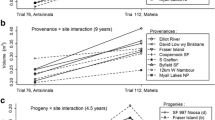Abstract
Growth traits and genetic diversity of 23 provenances of Quercus rubra introduced from North America were analyzed in a provenance trial established with a randomized block design in Hwaseong, Gyeonggi, South Korea in 1993. Growth variables and survival at age 25 were compared with results from early stages. Height, DBH, volume and stem straightness of Q. rubra was better than those of the domestic oak (Quercus accutissima). Growth of the Dunham Island provenance from New York was the best among the 23 provenances that of the Eagle River provenance from Wisconsin was poorest. Survival rate at age 25 was on average 52%. The longitude of seed origin and growth of provenance were consistently significantly negatively correlated at all ages. Growth of coastal provenances was superior to that of the inland provenances, which were separated by the Appalachian Mountains. Genetic diversity and genetic distance among the provenances were evaluated using microsatellite markers. The allelic frequencies showed high polymorphism in 10 microsatellite loci, and 292 alleles were found. Of 10 loci, two were commonly found in the 23 provenances. The mean allelic diversity and heterozygosity observed among the provenances were similar to those from the native populations of Q. rubra in North America. Nei′s genetic distance among the 23 was estimated and showed that a clear trend between geographic and genetic distances, indicating that some provenances have high genetic diversity with superior growth performance.



Similar content being viewed by others
References
Aldrich PR, Charles H, Michler WS, Romero SJ (2002) Microsatellite markers for northern red oak (Fagaceas: Quercus rubra). Mol Ecol Notes 2:472–474
Cho DH, Ryu KO, Kim IS, Lee JH, Park JI (2013) Comparison of growth performance and stem straightness among 23 provenances of Quercus rubra Linne. J Korean Breed Sci 45(4):369–376
Choi HS (2010) Growth performance of Pinus strobus provenances and provenance x site interaction in Korea. PhD dissertation. Seoul National University, pp. 97–103.
Choi HS, Ryu KO, Hyun JO (2009) Growth characteristics of Eastern white pine (Pinus strobus L.) with six provenances in a Hwasong plantation. J Korean Breed Sci 41(3):271–278
Godfrey RK (1988) Trees, shrubs, and woody vines of northern Florida and adjacent Georgia and Alabama. The University of Georgia Press, Athens, GA, p 734
James JZ, Kim CS, Todd WB (1996) Northern red oak planting stock: 6-year results. New Forest 13:175–189
Jeong JH, Kim JH, Jo A, Kim YY (2014) Genetic variation in six seed stands of Quercus variabilis. In: Proceeding of the Korean Society of Forest Science, pp. 288–289.
Kim IS, Ryu KO, Choi HS, Kwon HY (2009) Provenance test of major species. Korea Forest Research Institute, Seoul, pp 15–16
Kleinschmit J, Otto H, Sauer A (1975) Möglichkeiten der züchterischen Verbesserung von Steil- und Traubeneiche (Quercus robur und Q petraea). Allg Forst Jagdztg 146:157–166
Kwon YR, Ryu KO, Choi HS, Kwon HY, Ahn YH (2007) Growth performance among 12 provenances of 30-year-old loblolly pine (Pinus taeda L.) in Wanju, southern part of Korea. J Korean Breed Sci 39(4):418–418
McGee CE, Loftis DL (1986) Panted oaks perform poorly in North Carolina and Tennessee. North Appl For 3:114–116
Peakall R, Smouse PE (2012) GenAlex 6.503: Genetic analysis in Excel. Population genetic software for teaching and research-an update. Bioinformatics 28:2537–2539
Priyanka DK (2017) Characterization of genetic microsatellite markers (EST-SSRS). In: Curtis MA (ed) The endangered oak species Quercus georgiana. Michigan Technology University, Houghton, pp 16–32
R Core Team (2012) R: A language and environment for statistical computing. R Foundation for Statistical Computing, Vienna, Austria. http://www.R-project.org/. Accessed 10 June 2019
Ryu KO, Han MS, Kim IS, Lee JH, Lee JC (2013) Adaptation test of Scots pine (Pinus sylvestris L.) in Korea: thirty-six-year-old growth performance of twenty-two provenances. Korean J Plant Resour 26(1):26–35
Ryu KO, Kwon OW, Song JH, Kim IS (2004) The variation of growth performance, timing of leaf burst and leaf from among 23 provenances of Quercus rubra L. in Korea. J Korean For Soc 93:235–241
Sander IL (1990) Quercus rubra L. northern red oak. In: Rusell BM, Honkala BH (eds) Silvics of North America. Volume 2. Hardwoods. Agric. Handbook 654. Washington, DC, USDA, Forest Service, pp 727–733
Stephan BR, Liesebach M (1996) Results of the IUFRO 1982 Scots tine (Pinus sylvestris L.) provenance experiment in Southwestern Germany. Silvae Genetica 45:342–349
Stephanie QG (2010) Microsatellite genetic diversity of Northern red oak (Quercus rubra L.) in Western North Carolina. Pre- and post-chestnut blight and pre- and post-harvest. Western Carolina University, North Carolina, p 76
Valerie LC, Guy R, Anne Z, Antoine K (1998) Geographical structure of gene diversity in Quercus petraea (Matt.) Liebl. III. Patterns of variation identified by geostatistical analyses. Heredity 80:464–473
Xiaomeng S, Qiang W, Mu C, Xon G, Li-an X (2017) Genetic diversity and structure of natural Quercus variabilis population in China as revealed by microsatellites markers. Forests 495:1–16
Author information
Authors and Affiliations
Corresponding author
Additional information
Publisher's Note
Springer Nature remains neutral with regard to jurisdictional claims in published maps and institutional affiliations.
Project funding: This study was supported by a research project (No. FTIS 2014109B0-1820-AA01) of Korea Forest Service and the Seoul National University Carbon Sink Graduate Program provided by Korea Forest Service & Korea Forestry Promotion Institute.
The online version is available at http://www.springerlink.com.
Corresponding editor: Yanbo Hu.
Rights and permissions
About this article
Cite this article
Kim, KW., Lee, KM., Kwon, SH. et al. Performance and genetic diversity of 23 provenances of northern red oak (Quercus rubra L.) after 25 years of growth in South Korea. J. For. Res. 32, 2181–2188 (2021). https://doi.org/10.1007/s11676-020-01283-8
Received:
Accepted:
Published:
Issue Date:
DOI: https://doi.org/10.1007/s11676-020-01283-8




